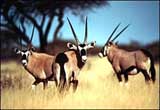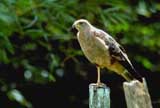 |
|
| Fit for the Wild |
 |
|
|
|

The immense grasslands of the East African Serengeti contain the earth's highest concentrations of Savannah animals adapted to grass plains. Each year, as the wet summer fades in May, 1.3 million blue wildebeest set out from the short grass plains in the southeast. In winding columns that stretch for kilometers, they move north towards the equator, pursuing fresh pastures and tropical rainfall.
With an annual rainfall of about 25 centimeters, the Kalahari doesn't rate as a true desert. The animals of the Kalahari fight a resourceful battle to survive this sparsely watered wildness. They are adapted to the semi-desert. The Kalahari offers little protective vegetation to the meerkats, yet brims with their natural enemies. These small mongoose-like creatures overcome any challengers of the semi-desert through physical and social adaptations.
 Some nocturnal mammals require a dark, safe, underground home to spend time during the daylight hours. The animals are adapted to the underground. These African wild dogs have to anchor at a den. Without the protection of the den, the cubs would fall prey to competing carnivores such as lions. Indeed, hyenas possess the highest cub survival rate of all carnivores, losing only 20 to 30 percent of cubs, largely due to the clan's reliance on the den. Some nocturnal mammals require a dark, safe, underground home to spend time during the daylight hours. The animals are adapted to the underground. These African wild dogs have to anchor at a den. Without the protection of the den, the cubs would fall prey to competing carnivores such as lions. Indeed, hyenas possess the highest cub survival rate of all carnivores, losing only 20 to 30 percent of cubs, largely due to the clan's reliance on the den.
(CCTV-2, Earth Stories, Dec.4-6)
|
|
| Editor: Zhao Xuan CCTV.com |
|
|
|
|
|
 |



